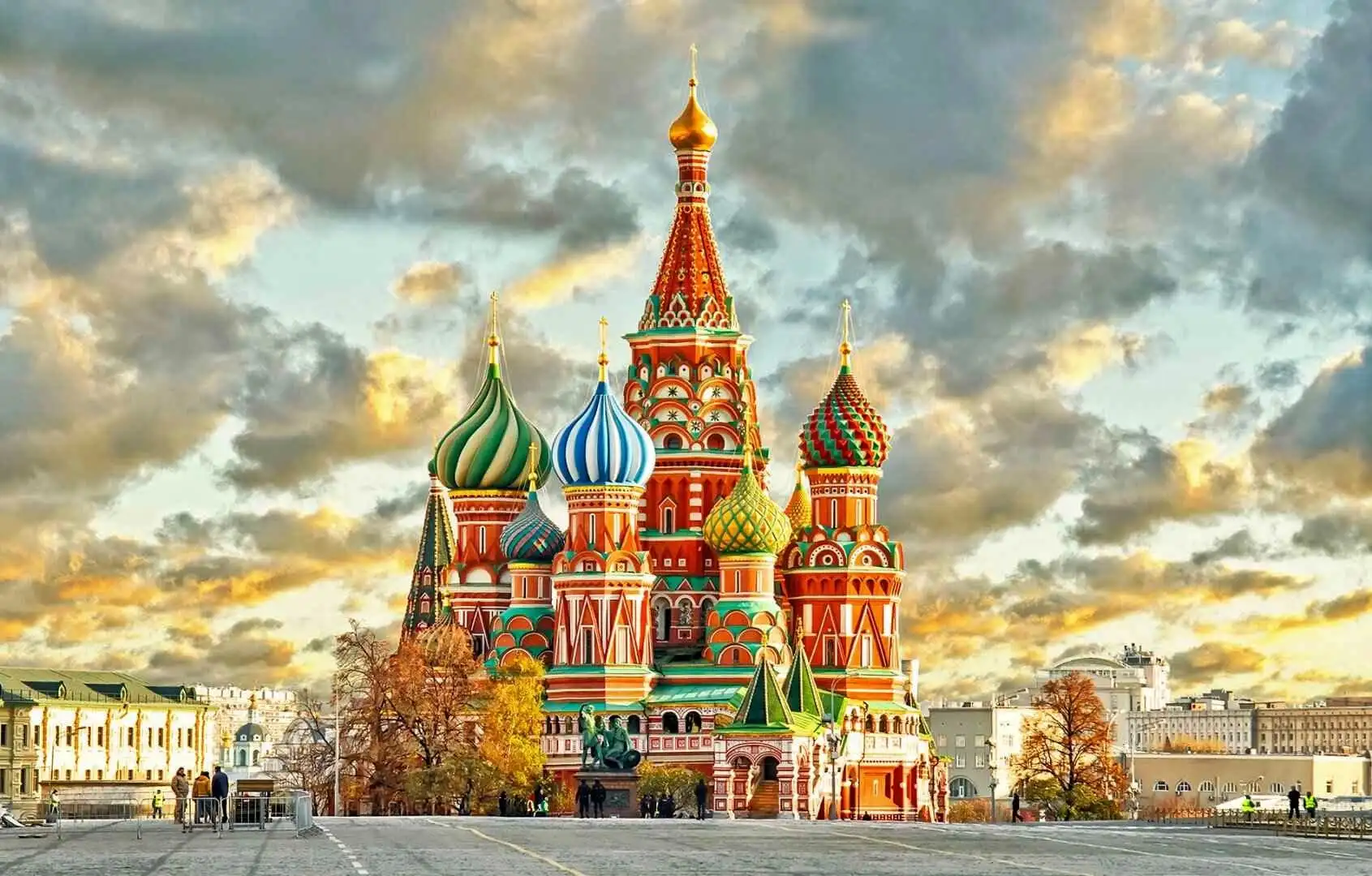
St. Basil’s Cathedral, an iconic symbol of Moscow, is renowned for its vibrant colors and unique architectural style. Completed in 1561 under the reign of Ivan the Terrible, this masterpiece of Russian architecture boasts a rich history filled with legends, cultural significance, and artistic achievement. Its stunning design and historical importance make it a must-visit landmark, attracting millions of tourists and photographers from around the world each year. Here, we explore some fascinating trivia about this remarkable cathedral.
Location: St. Basil’s Cathedral is prominently situated on Red Square, which is one of the most famous public spaces in Moscow. This square serves as a central hub for the city and is surrounded by significant landmarks, including the Kremlin and the State Historical Museum. The cathedral’s location enhances its visibility and importance, making it a focal point for both tourists and locals. Red Square itself has been a site of historical events, parades, and gatherings, contributing to the cathedral’s status as a cultural icon.
Construction Period: The construction of St. Basil’s Cathedral began in 1555 and was completed in 1561, a remarkably short time for such an intricate structure. Commissioned by Tsar Ivan IV, known as Ivan the Terrible, the cathedral was built to commemorate his military victories, particularly the conquest of the Khanate of Kazan. The rapid construction reflects the urgency and importance placed on the cathedral as a symbol of Russian power and religious devotion during the era.
Architects: The cathedral is traditionally attributed to the architects Barma and Postnik Yakovlev. Their exact identities and the details of their contributions remain somewhat shrouded in mystery, but they are celebrated for their innovative design that combines various architectural styles. The blend of Russian, Byzantine, and Islamic influences in the cathedral’s design is a testament to the cultural exchanges occurring during that period in Russia, showcasing a unique architectural achievement that stands out in the landscape of Moscow.
Design: St. Basil’s Cathedral is renowned for its distinctive architectural style, which features a series of colorful, onion-shaped domes that rise dramatically against the Moscow skyline. The design is a departure from traditional church architecture, incorporating elements that reflect Russian folk art and the aesthetic sensibilities of the time. Each dome is uniquely shaped and decorated, contributing to the overall whimsical appearance of the cathedral. This design not only serves religious purposes but also symbolizes the unity of different cultures and influences that shaped Russia.
Height: The tallest dome of St. Basil’s Cathedral reaches an impressive height of approximately 65 meters (213 feet). This height was significant for its time, making it one of the tallest structures in Moscow at the time of its completion. The elevation of the main dome, often seen as a symbol of heaven, draws the eye upward and enhances the cathedral’s spiritual presence. The height and grandeur of the structure serve to inspire awe and reverence among visitors, reinforcing its status as a monumental religious site.
Domes: The cathedral features a total of nine onion-shaped domes, each adorned with intricate designs and vibrant colors. These domes are not only visually striking but also serve symbolic purposes, representing the various aspects of the Orthodox faith. Each dome corresponds to a different chapel within the cathedral, creating a harmonious architectural composition. The diverse colors and patterns of the domes reflect the artistic styles of the time and contribute to the cathedral’s status as a masterpiece of Russian architecture.
Color: The vibrant colors of St. Basil’s domes are achieved through the use of glazed tiles, which were a popular decorative element in Russian architecture. The tiles are made from clay and are coated with a glossy finish that allows them to shine in sunlight, creating a stunning visual effect. The colorful design not only enhances the cathedral’s aesthetic appeal but also symbolizes the joy and celebration associated with the Orthodox faith. The use of bright colors is characteristic of Russian architecture and reflects the cultural identity of the nation.
UNESCO World Heritage Site: St. Basil’s Cathedral was designated a UNESCO World Heritage Site in 1990, recognizing its outstanding universal value and cultural significance. This designation helps to ensure the preservation of the cathedral and its historical context for future generations. Being part of the UNESCO list highlights the cathedral’s importance not only to Russia but to the world, as it represents a unique blend of architectural styles and historical narratives that have shaped the region’s identity.
Historical Significance: The cathedral was built to commemorate the successful military campaigns of Ivan IV, particularly the capture of Kazan and Astrakhan, which were crucial victories in the expansion of the Russian state. Its construction marked a turning point in Russian history, symbolizing the transition from a fragmented collection of principalities to a unified state under Ivan the Terrible. St. Basil’s Cathedral stands as a testament to this pivotal moment, reflecting the aspirations and ambitions of the Russian Empire during the 16th century.
Interior: The interior of St. Basil’s Cathedral is as remarkable as its exterior, featuring a complex arrangement of chapels and vibrant frescoes that adorn the walls. Each chapel is dedicated to a different saint, with intricate details and religious iconography that reflect the Orthodox Christian faith. The design of the interior is characterized by its labyrinthine layout, which creates a sense of exploration and discovery for visitors. The walls are adorned with colorful frescoes that depict scenes from the Bible, saints, and various religious motifs, contributing to the spiritual atmosphere of the cathedral. The use of light within the interior, filtered through the domes, enhances the ethereal quality of the space, inviting contemplation and reverence. The rich artistry and craftsmanship found within St. Basil’s Cathedral highlight the importance of religion in Russian culture and the dedication of the artisans who created this masterpiece.
Symbolism: The design of St. Basil’s Cathedral is rich in symbolism, particularly the representation of the burning bush seen by Moses in the biblical narrative. This imagery reflects the cathedral’s dedication to the Orthodox Christian faith and signifies divine presence and revelation. The unique shape of the domes, resembling flames, reinforces this symbolism, emphasizing the connection between heaven and earth. This deep spiritual significance enhances the cathedral’s role as a place of worship and a beacon of faith within the Russian Orthodox Church.
Dimensions: St. Basil’s Cathedral covers an area of approximately 1,000 square meters (10,764 square feet), making it a relatively compact yet visually striking structure. Despite its size, the cathedral’s intricate design and towering domes create an impression of grandeur and majesty. The dimensions of the building allow for a complex arrangement of chapels and spaces, each serving different liturgical purposes. The scale of the cathedral, combined with its elaborate details, contributes to its status as one of the most recognizable architectural landmarks in the world.
Renovations: Over the centuries, St. Basil’s Cathedral has undergone several renovations, with the most significant occurring in the 17th century. These renovations were necessary to preserve the structure and restore its original beauty after years of wear and damage. The restoration efforts included repairing the frescoes, replacing damaged tiles, and reinforcing the building’s foundations. The careful attention to detail during these renovations has helped maintain the cathedral’s historical integrity, allowing it to continue to serve as a vital cultural and religious site.
Visitor Attraction: St. Basil’s Cathedral is one of the most visited tourist attractions in Russia, drawing millions of visitors annually from around the world. Its iconic status, stunning architecture, and rich history make it a must-see destination for anyone traveling to Moscow. Visitors are often captivated by the cathedral’s colorful domes and intricate details, as well as the opportunity to explore its interior chapels. The cathedral’s location on Red Square further enhances its accessibility, making it a central point for cultural exchange and tourism in the city.
Cultural Icon: St. Basil’s Cathedral is not only a religious site but also a cultural icon that represents Russia and Moscow in various forms of media. Its distinctive silhouette and vibrant colors have made it a popular subject in photographs, paintings, and films, symbolizing the rich history and artistic heritage of the nation. The cathedral’s image is often used in promotional materials and souvenirs, reinforcing its status as a national treasure. As a cultural landmark, St. Basil’s Cathedral helps to shape the identity of Moscow and serves as a source of pride for the Russian people.
Preservation: Since the Soviet era, St. Basil’s Cathedral has been preserved as a museum, specifically since 1929. This transition from a functioning church to a museum reflects the changing political and cultural landscape of Russia during the 20th century. As a museum, the cathedral allows visitors to learn about its history, architecture, and significance within the Orthodox faith. The preservation efforts have included maintaining the structural integrity of the building, conserving its artistic elements, and providing educational resources to enhance public understanding of its cultural importance.
Artistry: The interior walls of St. Basil’s Cathedral are adorned with stunning frescoes and intricate details that showcase the artistry of the period. These frescoes depict a variety of religious scenes, saints, and ornamental motifs, illustrating the skill and creativity of the artists who worked on the cathedral. The vibrant colors and elaborate designs reflect the Byzantine influence on Russian art, creating a visually captivating environment that enhances the spiritual experience for worshippers and visitors alike. The artistry within the cathedral serves as a testament to the cultural and religious devotion of the time.
Surrounding Area: St. Basil’s Cathedral is strategically located near the Kremlin, which is a significant historical and political site in Russia. The proximity of these two landmarks emphasizes the importance of St. Basil’s within the context of Russian history and governance. The surrounding area, including Red Square, serves as a gathering place for public events, celebrations, and demonstrations, further integrating the cathedral into the social and political fabric of the city. This location enhances the cathedral’s visibility and accessibility, making it a central point for both religious and civic life in Moscow.
Height Comparison: St. Basil’s Cathedral, completed in 1561, was the tallest structure in Moscow until the Ivan the Great Bell Tower was finished in 1600. Standing at approximately 65 meters (213 feet) tall, the cathedral’s iconic onion domes and intricate design made it a dominant feature of the Moscow skyline for over three decades. Its height and unique architecture symbolize the artistic and cultural aspirations of Russia during the reign of Ivan the Terrible, reflecting the blend of different architectural styles that characterize the period.
Legends: A well-known legend surrounding St. Basil’s Cathedral is that Ivan the Terrible had the architects blinded after they completed the cathedral to ensure that they could never design anything as beautiful again. While there is no definitive historical evidence to confirm this story, it has persisted through the centuries, adding a layer of intrigue to the cathedral’s history. This tale underscores the often tumultuous relationship between power and creativity in Russian history, as well as the lengths to which rulers might go to maintain their legacy.
Material: The construction of St. Basil’s Cathedral primarily utilized brick and stone, showcasing the architectural techniques of the time. The exterior is adorned with vibrant, glazed tiles that create a striking visual contrast against the red brick. The use of these materials not only contributed to the cathedral’s aesthetic appeal but also to its durability. The intricate details and colorful patterns on the domes are a hallmark of Russian architecture, representing a fusion of Byzantine and traditional Russian styles that became emblematic of the region.
Public Access: St. Basil’s Cathedral is open to the public, allowing visitors to explore its chapels and learn about its rich history. This accessibility has made it a popular destination for tourists and locals alike. Inside, visitors can admire the stunning frescoes, intricate iconography, and unique architectural features that reflect the spiritual and cultural significance of the cathedral. Guided tours often provide insights into the cathedral’s construction, its role in Russian history, and its status as a UNESCO World Heritage Site.
Cultural Events: Over the centuries, St. Basil’s Cathedral has been the site of various cultural events and celebrations, reflecting its importance in Russian society. From religious ceremonies to national celebrations, the cathedral has served as a backdrop for significant moments in history. Its vibrant atmosphere during festivals and public gatherings highlights the cathedral’s role as a focal point for community and cultural identity in Moscow, making it a living part of the city’s heritage.
Presidential Events: St. Basil’s Cathedral has also been the backdrop for numerous state events and ceremonies, emphasizing its significance in the political landscape of Russia. The cathedral’s majestic presence lends an air of grandeur to official events, from state visits to national holidays. Its iconic silhouette against the Kremlin serves as a powerful symbol of Russian statehood and continuity, reinforcing the connection between the church and the state throughout history.
Photography: As one of the most photographed landmarks in the world, St. Basil’s Cathedral is frequently featured in travel brochures, media, and social media platforms. Its distinctive architecture and vibrant colors make it a favorite subject for photographers and tourists alike. The cathedral’s unique design, with its swirling onion domes and intricate details, provides endless opportunities for capturing stunning images. Its recognition as a symbol of Moscow and Russia further enhances its appeal as a must-visit destination for anyone exploring the city.
Frequently Asked Questions About St. Basil’s Cathedral
General Questions
1. What is St. Basil’s Cathedral?
- St. Basil’s Cathedral is an iconic Russian Orthodox church located on Red Square in Moscow, Russia. It is known for its colorful, onion-shaped domes and intricate architecture.
2. When was St. Basil’s Cathedral built?
- Construction of St. Basil’s Cathedral began in 1555 and was completed in 1561. It was commissioned by Ivan the Terrible to commemorate Russia’s victory over the Khanate of Kazan.
3. Who designed St. Basil’s Cathedral?
- The architects responsible for designing St. Basil’s Cathedral are unknown. Some historians believe that it was a collaborative effort by a group of architects, while others suggest that a single architect may have been involved.
4. What is the significance of the onion-shaped domes?
- The onion-shaped domes of St. Basil’s Cathedral are a distinctive feature of Russian Orthodox church architecture. They are believed to symbolize the flames of the Holy Spirit. The number of domes is said to represent the number of saints commemorated by the church.
5. What is the interior of St. Basil’s Cathedral like?
- The interior of St. Basil’s Cathedral is adorned with elaborate frescoes, mosaics, and icons. The main nave is a large, open space with a high ceiling, while the surrounding chapels are smaller and more intimate.
Specific Questions
1. Is St. Basil’s Cathedral a functioning church?
- Yes, St. Basil’s Cathedral is still a functioning church. However, it is primarily used for religious ceremonies and services on special occasions.
2. Can tourists visit St. Basil’s Cathedral?
- Yes, tourists are welcome to visit St. Basil’s Cathedral. There is a fee for admission, and guided tours are available.
3. What is the history of St. Basil’s Cathedral?
- St. Basil’s Cathedral was built to commemorate Russia’s victory over the Khanate of Kazan. It was originally a smaller wooden church, but it was later replaced by the larger, more ornate structure we see today. The cathedral has served as a place of worship, a museum, and a bell tower throughout its history.
4. What are some interesting facts about St. Basil’s Cathedral?
- Some interesting facts about St. Basil’s Cathedral include:
- It was once considered a symbol of Russian nationalism and imperial power.
- It was briefly converted into a museum during the Soviet era.
- It has been featured in numerous films and television shows.
- It is a UNESCO World Heritage Site.
5. What is the best time to visit St. Basil’s Cathedral?
- The best time to visit St. Basil’s Cathedral is during the shoulder seasons (spring or fall) when the crowds are smaller and the weather is pleasant. However, it is possible to visit the cathedral year-round.









